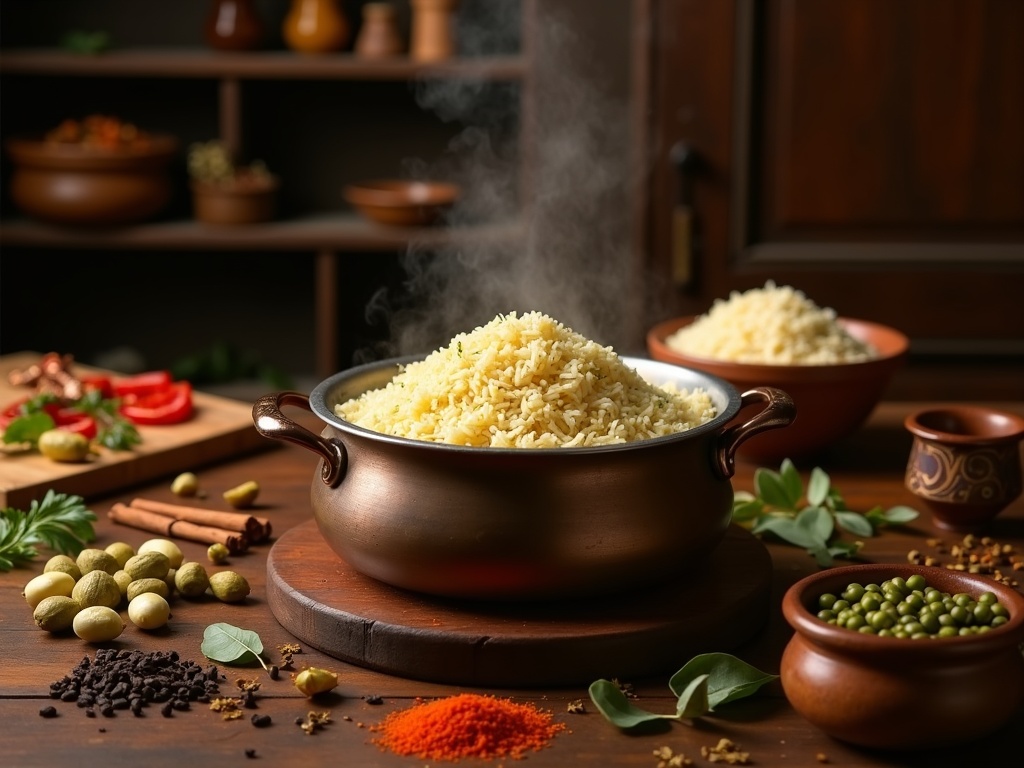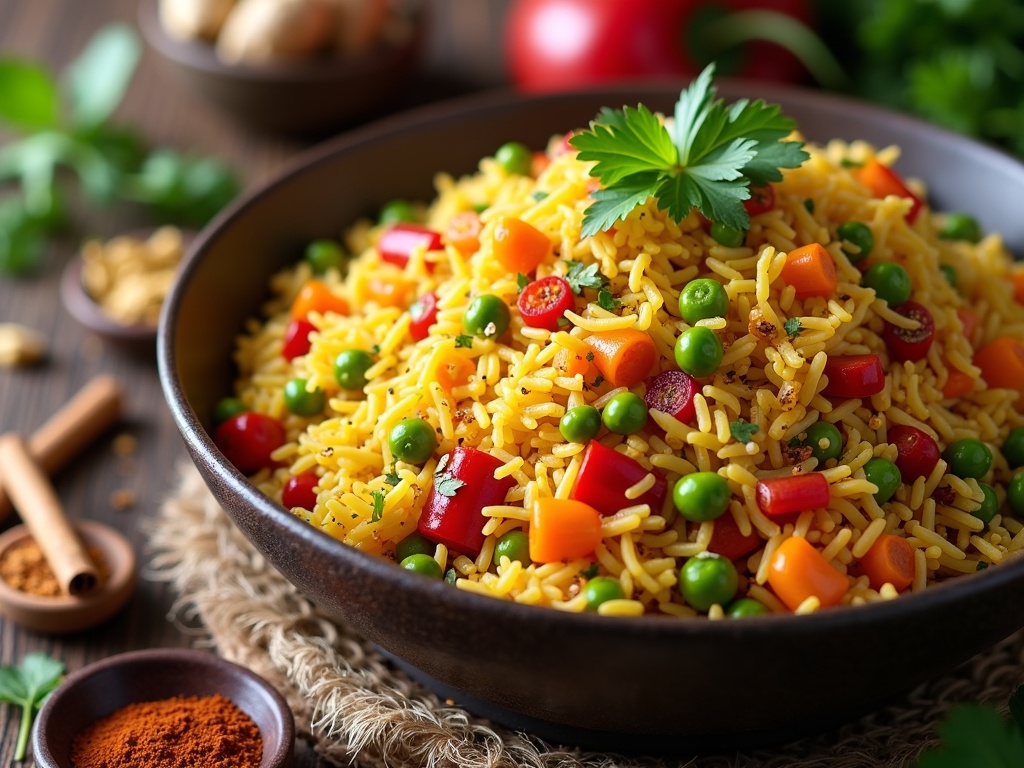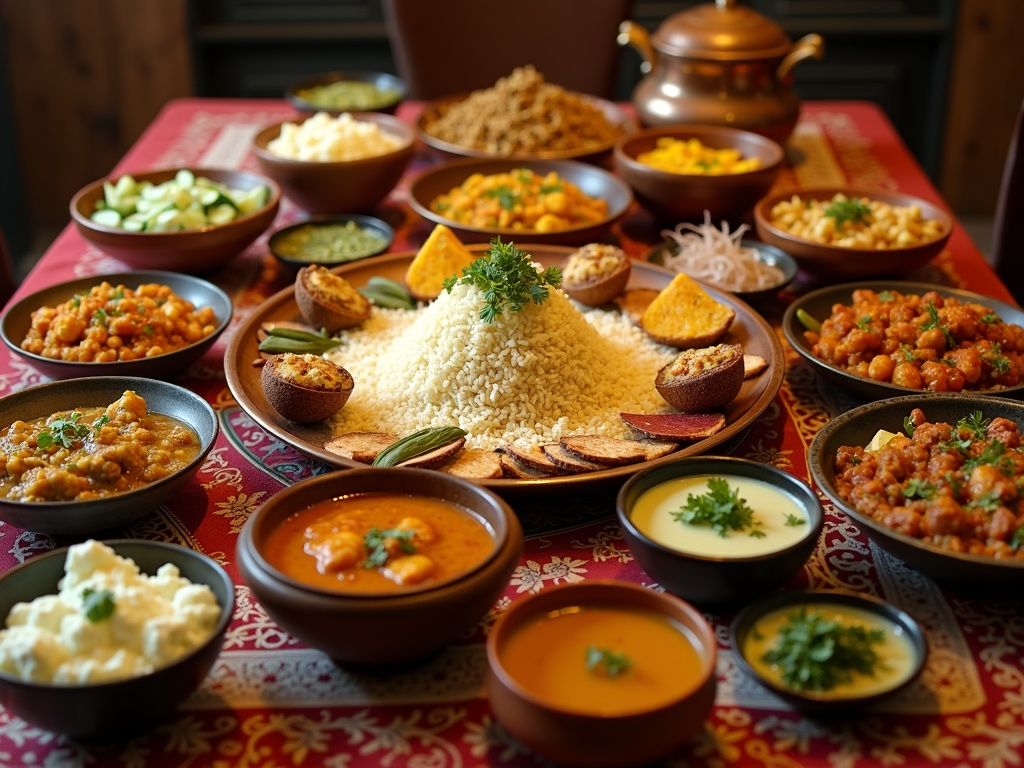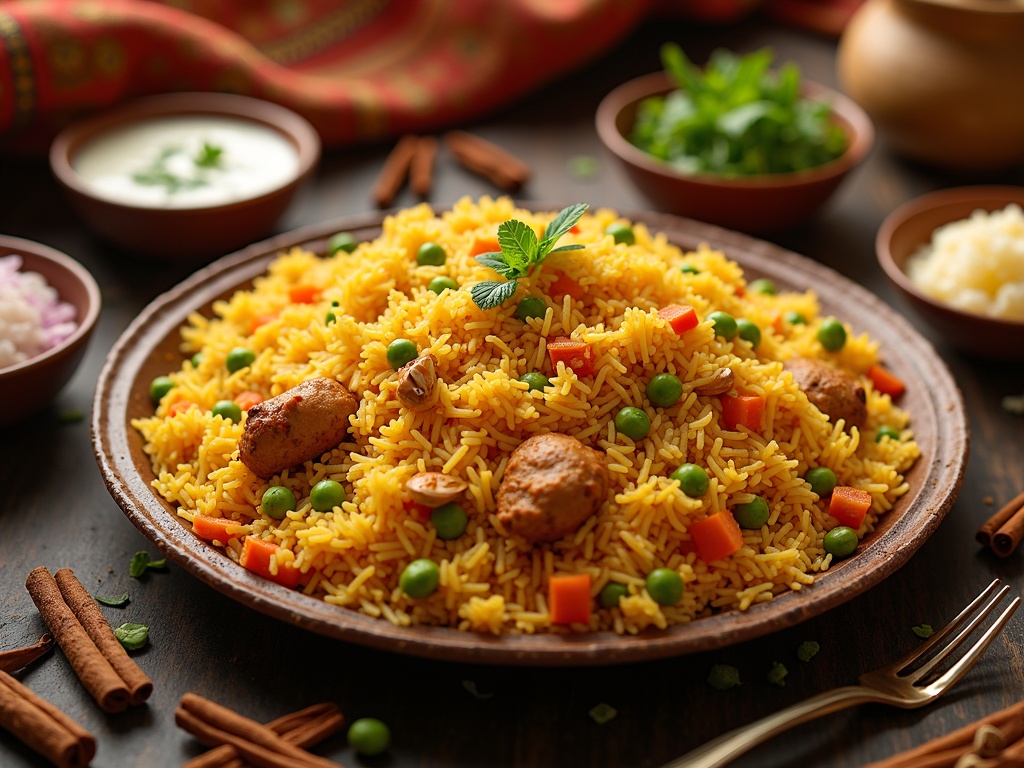Pulao, a cherished rice dish with Persian origins, has seen a remarkable 300% increase in online recipe searches as it continues to captivate food enthusiasts worldwide. This versatile dish combines fragrant basmati rice with aromatic spices, proteins, and vegetables, creating a perfect balance of flavors that has become a staple across South Asian countries including India, Pakistan, Afghanistan, and Bangladesh.
Find In This Article
Key Takeaways
- Traditional pulao requires fragrant basmati rice, whole spices like cardamom and cinnamon, protein or vegetables, ghee or oil, and stock or broth.
- The “dum” cooking method is essential for perfect pulao, involving slow cooking with a tight-fitting lid for 15-20 minutes to ensure distinct yet tender rice grains.
- Regional varieties abound across South Asia, from sweet Kashmiri pulao with dried fruits to spice-forward Hyderabadi pulao with meat.
- A vegetarian pulao contains approximately 250-300 calories per serving with 5-8g of protein, while chicken pulao offers 15-20g of protein.
- Traditional accompaniments like raita, mint chutney, and onion salad perfectly balance and enhance the flavors of pulao.
The Art of Making Traditional Pulao
Pulao represents one of the most cherished rice dishes in South Asian cuisine, with roots tracing back to the Persian “polo.” I’ve noticed its popularity soaring in recent years, with Google Trends reporting a remarkable 300% increase in online searches for pulao recipes. This ancient dish has captured the hearts and palates of food enthusiasts worldwide, and for good reason.
The Rich Heritage and Essential Components
Pulao has become a staple across South Asia, gracing dining tables in India, Pakistan, Afghanistan, and Bangladesh. Each region has developed its own unique take on this classic dish, but the fundamentals remain consistent. India alone produces over 100 million tons of rice yearly, much of which goes into creating dishes like authentic pulao that families enjoy daily.
The beauty of pulao lies in its perfect balance of flavors and textures. At its core, the dish requires:
- Fragrant basmati rice: The long, slender grains remain separate when cooked properly, creating that distinctive fluffy texture.
- Aromatic spices: Whole spices like cardamom, cloves, cinnamon, and bay leaves infuse the rice with complex flavors.
- Protein and vegetables: Traditional versions may include chicken, mutton, or for vegetarian pulao options, a medley of seasonal vegetables.
- Ghee or oil: The fat component carries the flavors throughout the dish.
- Stock or broth: This liquid element absorbs into the rice, carrying the essence of all ingredients.
The secret to exceptional pulao isn’t just in the ingredients but in the technique. I always start by blooming whole spices in hot ghee or oil, creating an aromatic foundation. This step releases the essential oils within the spices, transforming them from mere seasonings into flavor powerhouses.
Next comes the rice—preferably soaked for 30 minutes beforehand—which gets lightly sautéed to coat each grain with the flavored fat. This crucial step prevents clumping and ensures each grain absorbs the spices evenly. The cooking liquid, whether stock, broth, or water, must maintain the perfect ratio to rice (typically 1.5:1 or 2:1 depending on the rice variety).
Unlike its cousin pilau rice, which often separates the cooking of rice and additives, traditional pulao combines everything in a single pot, allowing flavors to meld completely. The key distinction lies in the layering technique used in biryani versus the mixed approach in pulao.
For optimal results, I always finish cooking pulao with the “dum” method—covering the pot with a tight-fitting lid, reducing the heat to its lowest setting, and allowing the rice to steam in its own aromatic vapor for 15-20 minutes. This final touch ensures perfectly cooked grains that remain distinct yet tender.
What makes pulao truly special is its versatility. From modest family dinners to lavish celebrations, this dish scales beautifully to suit any occasion. The beauty lies in how something so seemingly simple—rice cooked with spices—can transform into a complex, satisfying meal that carries centuries of culinary wisdom.
Whether you’re crafting a vegetable-laden version for everyday meals or an elaborate meat pulao for special gatherings, mastering this traditional dish connects you to a rich culinary heritage shared by millions across South Asia and beyond.
Popular Regional Varieties Across South Asia
South Asia boasts an incredible diversity of pulao recipes, with flavors and techniques that reflect local ingredients and cultural traditions. A staggering 67% of Indian households consume pulao regularly, making it one of the region’s most beloved rice dishes. With over 30 documented regional recipes across India alone, the variations seem endless – each telling a unique culinary story.
Regional Masterpieces
The beauty of pulao recipe lies in its adaptability across different regions, each adding their distinct touch:
Kashmiri Pulao stands out for its aromatic sweetness. This northern delight features dried fruits like apricots and cherries, alongside nuts such as almonds and pistachios. The rice often gets its distinctive yellow color from saffron, while cardamom, cinnamon, and cloves create a fragrant base. I’ve found that the Kashmiri version tends to be milder than other regional varieties, making it perfect for those who prefer subtle flavors.
Moving south, Hyderabadi Pulao represents a bold, spice-forward approach. This version typically features meat (often chicken or mutton) marinated in yogurt and spices before being cooked with rice. The signature spice blend includes star anise, stone flower (dagad phool), and mace, creating a complex flavor profile. The cooking technique often involves the dum method – slow cooking in a sealed pot to trap all aromas.
In Gujarat, the veg pulao gets a sweet-sour treatment with the addition of jaggery and sometimes dried fruits. The Bengali version might include panch phoron (a five-spice blend) and fish instead of meat. Tamil Nadu’s variant often features coconut milk and curry leaves for a South Indian twist.
Punjab offers a heartier take with abundant whole spices and sometimes potatoes or chickpeas. The pulao here tends to be more robustly spiced compared to other regions. In Kerala, you’ll find pulao made with short-grain rice varieties and often seasoned with coconut and curry leaves.
The Sindhi community prepares a unique version called Tahiri – a vegetarian pulao with potatoes and cauliflower as star ingredients. Meanwhile, in Nepal, the dish often includes local herbs and sometimes yak meat in mountainous regions.
Each region’s pulao reflects available ingredients and cultural preferences:
- Eastern regions often incorporate panch phoron and sometimes fish
- Northern variations frequently use dried fruits, nuts, and whole garam masala
- Western styles might include more legumes and seasonal vegetables
- Southern versions typically feature coconut, curry leaves, and tamarind
The cooking methods vary significantly too. While some regions prefer the layered approach similar to pilau rice, others cook everything together in one pot. The Lucknowi style famously uses the dum technique, where the pot is sealed with dough during cooking to trap steam and flavors.
Beyond just a meal, pulao holds deep cultural significance across South Asia. In Kashmir, it’s central to wazwan feasts. In Hyderabad, it’s served at important celebrations and weddings. Many families have their own treasured recipes passed down through generations, with subtle tweaks that make each household’s version unique.
I’ve discovered that the regional varieties of pulao tell a rich story of South Asia’s diverse culinary heritage – from the royal kitchens of Lucknow to the coastal communities of Kerala. Each spoonful offers a taste of local tradition and history that continues to evolve while honoring its roots.
Essential Cooking Techniques for Perfect Pulao
Making the perfect pulao recipe requires mastering a few key techniques that separate an average rice dish from an extraordinary one. I’ll guide you through the essential methods that will elevate your pulao cooking skills.
The Art of Dum Cooking
The traditional “dum” cooking method is at the heart of authentic pulao preparation. This slow-cooking technique involves sealing the pot with a tight lid, sometimes reinforced with dough, to trap steam and aromas. The gentle, indirect heat allows flavors to penetrate deeply into each grain of rice.
When using the dum method, I start by sautéing spices and other ingredients in ghee or oil, then adding soaked rice and liquid. After bringing to an initial boil, I reduce the heat to its lowest setting, seal the lid tightly, and let it cook undisturbed for 30-45 minutes depending on the rice variety. Basmati rice, which accounts for 30% of India’s rice exports according to agricultural reports, typically needs about 30 minutes, while other varieties might require more time.
Rice Preparation and Spice Selection
Proper rice preparation is crucial for achieving that perfect, fluffy texture in your veg pulao. Here’s how I ensure the best results:
- Rinse the rice thoroughly until the water runs clear, removing excess starch that can make your pulao sticky.
- Soak the rice for 20-30 minutes to allow grains to absorb moisture and cook more evenly.
- Drain completely before adding to your cooking pot.
Spice selection creates the signature aroma and flavor profile of a good pilau rice. I always include these essential spices:
- Cardamom pods (both green and black)
- Cloves
- Bay leaves
- Cinnamon sticks
- Cumin seeds
For vegetarian versions, I intensify the flavor using vegetable stock and often add more whole spices during the initial tempering stage. The aromatics need to be more pronounced since there’s no meat to contribute additional depth.
Non-vegetarian pulao benefits from the natural flavors in meat. I typically use fewer spices but cook them longer with the meat before adding rice. This creates a rich base that infuses the rice during the dum process.
The key to perfect pulao lies in these time-tested techniques. By mastering proper rice preparation, spice selection, and the dum cooking method, you’ll create a dish where each grain stands distinct yet carries the essence of all ingredients.

Health Benefits and Nutrition Facts
Pulao offers a balanced mix of carbohydrates, proteins, and essential nutrients while delivering amazing flavor. I’ve found that knowing the nutritional content helps make informed dietary choices without sacrificing taste or enjoyment.
Calorie Content and Macronutrients
A typical serving of vegetarian veg pulao contains approximately 250-300 calories, making it a moderate-calorie meal option. This contrasts with chicken pulao, which typically ranges from 350-450 calories per serving due to the added protein source. According to USDA data, a standard serving of basmati rice alone contains about 160 calories, which means the additional calories come from the aromatic spices, vegetables, and proteins added during preparation.
Protein content varies significantly between versions:
- Vegetarian pulao: 5-8g protein per serving (from rice, peas, and other vegetables)
- Chicken pulao: 15-20g protein per serving (with chicken being the primary protein source)
- Legume-based pulao (with lentils or chickpeas): 8-12g protein per serving
The fiber content in pulao recipe variations depends largely on the vegetables included. A vegetable-rich pulao can provide 4-6g of dietary fiber per serving, supporting digestive health and creating a feeling of fullness.
Nutritional Breakdown of Common Ingredients
Basmati rice, the foundation of pilau rice, provides complex carbohydrates that supply sustained energy. Beyond carbohydrates, pulao ingredients offer numerous micronutrients:
Cumin seeds contain iron, manganese, and essential oils with digestive benefits. Cardamom pods provide manganese, zinc, and compounds with anti-inflammatory properties. Fresh ginger delivers gingerol, which has powerful antioxidant and anti-inflammatory effects.
Vegetables commonly added to pulao contribute significant nutritional value:
- Carrots: Rich in beta-carotene, which converts to vitamin A in the body
- Peas: Good source of vitamins C, K, and plant-based protein
- Bell peppers: High in vitamin C and antioxidants
- Onions: Contain quercetin, an antioxidant with anti-inflammatory properties
When prepared with minimal oil, pulao can be part of a heart-healthy diet. The spices used not only enhance flavor but also offer potential health benefits—turmeric contains curcumin, which has been studied for its anti-inflammatory properties, while cinnamon may help regulate blood sugar levels.
I’ve found that pulao’s nutritional profile can be further enhanced by using brown basmati rice instead of white, which increases the fiber content and adds more nutrients while maintaining the dish’s essential character.

Best Accompaniments and Serving Suggestions
When I’m craving a complete meal, pulao recipes always come to mind. It’s no wonder that 75% of restaurants serve pulao as a main dish – this aromatic rice preparation stands strong on its own but truly shines when paired with the right accompaniments.
Traditional Pairings that Elevate Pulao
The beauty of vegetable pulao lies in how it can be transformed by what’s served alongside it. I’ve found that these classic accompaniments create the perfect balance:
- Raita is perhaps the most essential pulao partner. This cooling yogurt-based side dish helps balance the spices in the rice while adding a creamy texture contrast. Whether you prefer cucumber raita, boondi raita, or mint raita, each variety brings its own character to the meal.
- Mint chutney offers a bright, zingy counterpoint that cuts through the richness of pulao. The fresh herbal notes and slight tanginess complement the aromatic spices in the rice. I always prepare a small bowl of this vibrant green sauce for guests.
- Onion salad might seem simple, but it’s a game-changer. Thinly sliced onions with a squeeze of lemon juice, a sprinkle of salt, and sometimes chopped cilantro provide a crunchy texture and sharp flavor that cleanses the palate between bites of pilau rice.
Across different regions, the accompaniments vary significantly. In Northern India, pulao is often served with a spicy salan (curry) or korma. The gravy-based dishes add moisture and rich flavors to the relatively dry rice dish. In contrast, Southern Indian versions might come with coconut-based chutneys or spicy vegetable preparations like avial.
Gujarat offers pulao with kadhi – a tangy yogurt-based curry thickened with chickpea flour. The mild sourness of kadhi perfectly balances the aromatic rice. Meanwhile, in Hyderabad, mirchi ka salan (green chili curry) is the preferred accompaniment to their famous versions.
For special occasions, many families serve pulao with additional sides such as:
- Aloo gobi (potato and cauliflower curry)
- Dal makhani (creamy black lentil preparation)
- Paneer dishes like shahi paneer or matar paneer
- Mixed vegetable curry with seasonal vegetables
The cultural significance of these pairings runs deep. In many communities, serving pulao with specific accompaniments is tied to celebrations and traditions. During weddings in Northern India, pulao with korma represents prosperity and abundance. In Muslim households, pulao with meat curries is a staple during Eid celebrations.
What I find fascinating is how these accompaniments aren’t merely additions but essential components that complete the pulao experience. The cooling raita balances the warming spices in the rice. The crunch of an onion salad contrasts with the soft grains. The tanginess of chutney highlights the subtle flavors of the pulao.
The right accompaniments don’t just enhance flavors—they transform pulao from a dish into a complete meal experience. I’ve learned through years of cooking that even the simplest pulao can become extraordinary when paired thoughtfully with sides that complement its character.
When hosting dinner parties, I create a spread of different accompaniments, allowing guests to customize their plates according to their preferences. This approach turns a straightforward rice dish into an interactive dining experience that celebrates the rich culinary traditions behind this beloved food.

Sources:
Culinary Trends Digest, Rise of Indian Cuisine
South Asian Studies, Cultural Significance of Pulao
FAO, Statistics Global Rice Production
International Culinary Institute, Cooking Methods Guide

